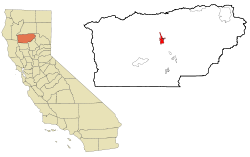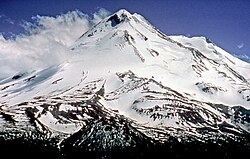2020
The 2020 United States census reported that Red Bluff had a population of 14,710. The population density was 1,945.5 inhabitants per square mile (751.2/km2). The racial makeup of Red Bluff was 69.6% White, 1.1% African American, 3.8% Native American, 1.6% Asian, 0.3% Pacific Islander, 11.6% from other races, and 12.2% from two or more races. Hispanic or Latino of any race were 24.5% of the population. [32]
The census reported that 97.7% of the population lived in households, 1.1% lived in non-institutionalized group quarters, and 1.2% were institutionalized. [32]
There were 5,755 households, out of which 33.8% included children under the age of 18, 33.3% were married-couple households, 10.2% were cohabiting couple households, 35.6% had a female householder with no partner present, and 20.9% had a male householder with no partner present. 31.2% of households were one person, and 14.9% were one person aged 65 or older. The average household size was 2.5. [32] There were 3,488 families (60.6% of all households). [33]
The age distribution was 26.1% under the age of 18, 9.2% aged 18 to 24, 26.2% aged 25 to 44, 21.5% aged 45 to 64, and 16.9% who were 65 years of age or older. The median age was 35.3 years. For every 100 females, there were 92.3 males. [32]
There were 6,114 housing units at an average density of 808.6 units per square mile (312.2 units/km2), of which 5,755 (94.1%) were occupied. Of these, 43.1% were owner-occupied, and 56.9% were occupied by renters. [32]
In 2023, the US Census Bureau estimated that 6.5% of the population were foreign-born. Of all people aged 5 or older, 87.3% spoke only English at home, 11.1% spoke Spanish, 0.2% spoke other Indo-European languages, 1.3% spoke Asian or Pacific Islander languages, and 0.1% spoke other languages. Of those aged 25 or older, 86.6% were high school graduates and 12.9% had a bachelor's degree. [34]
The median household income in 2023 was $50,216, and the per capita income was $40,159. About 15.4% of families and 17.6% of the population were below the poverty line. [35]
2010
At the 2010 census, Red Bluff had a population of 14,076. The population density was 1,833.6/sq mi (708.0/km2). The racial makeup of Red Bluff was 11,366 (80.7%) White, 128 (0.9%) African American, 438 (3.1%) Native American, 187 (1.3%) Asian, 16 (0.1%) Pacific Islander, 1,168 (8.3%) from other races, and 773 (5.5%) from two or more races. Hispanics or Latinos of any race were 3,037 persons (21.6%). [36] The census reported that 13,637 people (96.9% of the population) lived in households, 150 (1.1%) lived in noninstitutionalized group quarters, and 289 (2.1%) were institutionalized.
Of the 5,376 households, 2,033 (37.8%) had children under 18 living in them, 1,969 (36.6%) were opposite-sex married couples living together, 1,022 (19.0%) had a female householder with no husband present, 404 (7.5%) had a male householder with no wife present, 537 (10.0%) were unmarried opposite-sex partnerships, and 27 (0.5%) were same-sex married couples or partnerships. Also, 1,629 households (30.3%) were one person, and 678 (12.6%) had someone living alone who was 65 or older. The average household size was 2.54. There were 3,395 families (63.2% of households); the average family size was 3.11.
The age distribution was 3,950 people (28.1%) under 18, 1,534 people (10.9%) were 18 to 24, 3,561 people (25.3%) were 25 to 44, 3,157 people (22.4%) were 45 to 64, and 1,874 people (13.3%) were 65 or older. The median age was 32.2 years. For every 100 females, there were 92.4 males. For every 100 females 18 and over, there were 87.7 males.
The 5,872 housing units had an average density of 764.9/square mile, of the occupied units 2,277 (42.4%) were owner-occupied and 3,099 (57.6%) were rented. The homeowner vacancy rate was 3.5%; the rental vacancy rate was 7.3%. 5,652 people (40.2% of the population) lived in owner-occupied housing units and 7,985 people (56.7%) lived in rental housing units.








